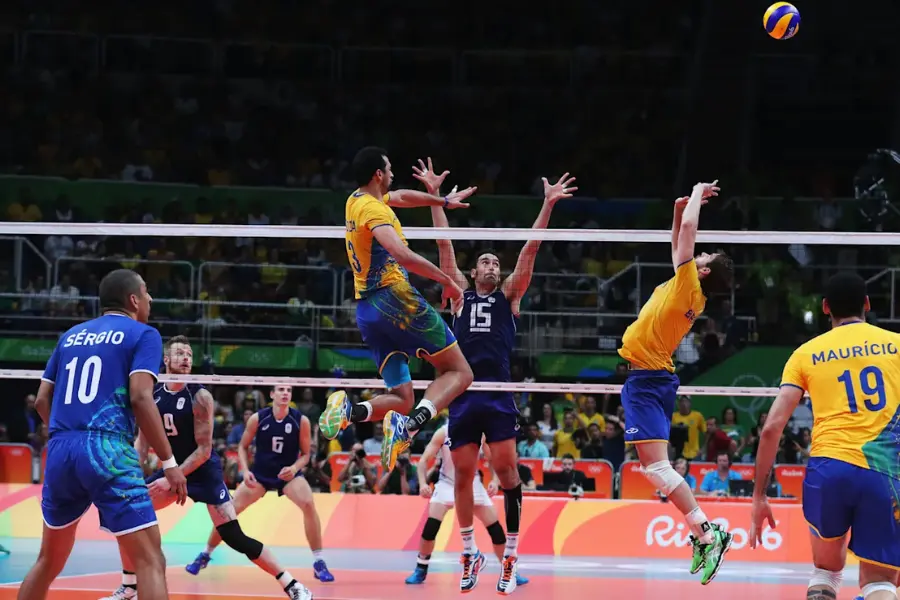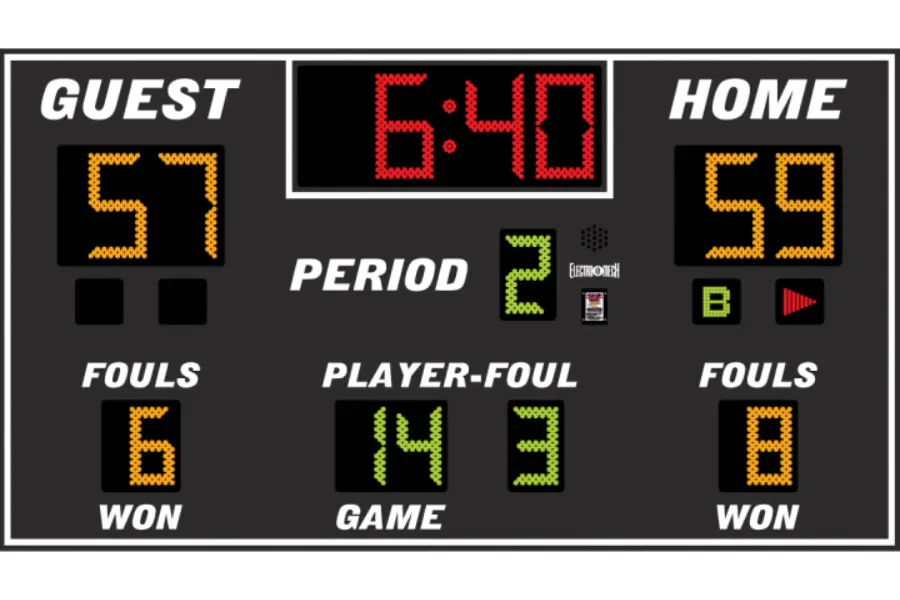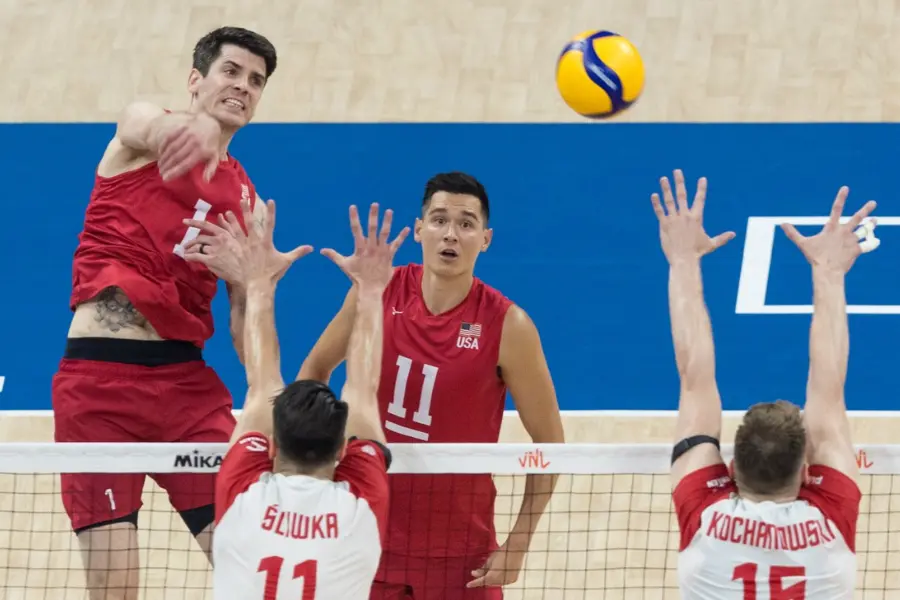There is a rally scoring system used in volleyball that awards a point after every rally. Points can be scored by either the serving team or the receiving team, no matter which team serves the ball.
Newcomers to the volleyball community always have questions about volleyball scoring. The scoring system in volleyball is frequently asked about, and what the heck does rally scoring mean?
A rally score is used in all modern volleyball games. Every time a rally is won, the winning team is awarded a point.
There are multiple plays in a rally, so every rally is a play. Points may be awarded to a team even if the play does not really get off to a good start.
In other words, even if one team misses their serve, the other team gains a point. The team that didn’t make the mistake wins a point even if there is a fault before the serve (such as an error in the rotation).
How Rally Scoring Works

The ball is scored every time it hits the court within the boundaries or when it makes an error.
No matter whether they served the ball or not, the team that did not make the error or allowed the ball to hit on their side is awarded a point. After winning a point, the winning team serves for the next one.
The Old System: Side Out Scoring
The “side out” scoring system was used prior to the implementation of the rally scoring system. A point could only be scored by the team that was serving the ball in this system.
In recognition of a rally win, the team not serving the ball would not receive a point. Instead, they would serve themselves, and if they won, they would score a point.
You may enjoy reading What Does Mh Mean In Volleyball?
Rally Scoring Adoption
In 1999, rally scoring became official. A major reason for the change from side out scoring to rally scoring was to make volleyball matches longer and more predictable for spectators and television viewers. According to the USA Volleyball Rules of the Game Commission, the event is as follows:
A number of major rules changes were adopted by the USA Volleyball Rules of the Game Commission in February 1999, which will significantly affect tournament planning and organization. Below are the significant changes in the scoring system, substitution numbers, sanctions, and referee signal techniques.
There will also be some movement in 1999 toward adopting the FIVB system of scorekeeping. This change reflects the requirement to use the FIVB rules as a basis for the United States Rules.
As of November 1, 1999, these rule changes will apply to USA Volleyball competition for the 1999-2000 season. In San Jose, Calif., May 31-June 3, the 1999 USA Volleyball Open Championships will follow the entire FIVB rule set with some safety modifications.
With all rally scoring, tournament organizers can better predict match-time requirements since sets and matches will take less time on average. According to the reconstructed sanction system and procedure, referees will be able to better control real misconduct, while participants will be free to express their natural feelings during each rally.
Why Is Rally Scoring Difficult?

Counter intuitive
Is there a way for your team to win a point even if they don’t accomplish anything? The answer is yes!
If your team does not even have possession of the ball for any part of a play, but the other team gets enough penalties or mistakes and you get credit for a touchdown, what would happen?
How would you feel if you watched baseball and your team didn’t leave the dugout, but still managed to score a few runs?
First of all, it just feels unnatural. After a while, it seems this shouldn’t be the way it is.
As long as both teams work this way consistently, it’s fair. Since the rules are known and consistent, each team has an equal chance of scoring points if they play within them.
Old scoring system
Side-out scoring used to be called this. You needed to serve the ball AND win the rally in order to score a point. Most of us (myself included) played under these rules as children, and never gave it a second thought.
A turn playing the offense or possession of the ball is essential to scoring in many other sports. In volleyball, it’s common for your team to switch between offense and defense numerous times during a rally.
You may enjoy reading Grass Volleyball Rules
Volleyball Rally Scoring vs Side Out Scoring
“Side out” scoring systems were used before rally scoring was implemented. The serving team could only score points in side outscoring. Instead of getting a point, the receiving team would get the serve, then if they won the rally, they would score.
Volleyball games were incredibly long due to this scoring system. It was possible that there would be no score indefinitely. Whenever a team loses the serve after each rally, no points are awarded!
How Did Volleyball Change To Rally Scoring?
Rally scoring has a few advantages that far outweigh its disadvantages. As of 2000, leagues switched over to rally scoring, depending on the level of volleyball.
Pros Of Rally Scoring
The game becomes much more exciting and entertaining when every rally earns a point. Nowadays, volleyball is a sport that is very fast-paced, exciting, and up-tempo.
Short and limited time-outs and short intervals between sets and matches support this culture.
Considering that, how many team sports would you be able to watch the entire match in under an hour and a half, and at most two hours, on a consistent basis? Consider the fact that that time may be divided into five sets during the match!
Volleyball has changed dramatically since the days when teams traded serves and the score remained the same.
Each play earns a point, so each set is limited to a certain number of plays. It was possible to trade serves back and forth without the scoreboard number changing once under the old system, so games would drag on!
It would simply be a very short game if every serve was an error in today’s volleyball.
As long as you follow the “win by 2” rule, the game can theoretically keep going on for as long as you want. Each team would have to trade points over and over again, and nobody would ever get ahead by two. Real-world teams rarely get over 27 or 28 points, although this is theoretically possible.
The second advantage of limiting rallies is that a game can be projected to take a specific amount of time more consistently. Especially in tournaments, this is a huge help when it comes to scheduling.
Suppose you’re playing in a tournament where over 100 teams are divided up into four pools of four teams each. A best of three set match will be played today between your team and three opponents.
An organizer can organize a huge tournament when they can play one game per hour. Although staying on pace is still a challenge, it is at least possible.
Cons To Rally Scoring
At the end of the game, it doesn’t seem fair to win a point because someone else failed. When your team wins, it’s strange to see your opponent make a serving error and jump for joy.
In reality, this happens in other sports as well, it’s just that volleyball feels different, especially in younger age groups. Your child’s serve is hit into the net and your child loses the game instantly as the crowd cheers.
Every mistake, no matter how small, results in a point loss. Often when scoring sideouts, you end up giving the serve back, but when scoring rallies, it always costs you a point.
Other sports are also similar to this. If your team lines up wrong, or has too many players on the field when they break the huddle, you lose yardage (and your opponents gain it). Volleyball differs from basketball in that points are added to the scoreboard.
You may enjoy reading Types of Serves in Volleyball
Volleyball scoreboards

All the sets in a match can be displayed on many volleyball scoreboards at once.
Officials usually use electronic scoreboards during volleyball games. Scoreboards are usually displayed above the game and on the scorer’s table so that players, coaches, and referees can see them without turning their heads.
A big electronic scoreboard on the wall usually isn’t useful in tournaments because there are too many games to keep track of. There will often be only one scoreboard on the scorer’s table in many tournaments.
Scores are kept on a flipping scoreboard at the scorer’s table.
Whatever the venue or situation, flip scoreboards are commonly used. It is possible to have an electronic version of the scorer’s table in some cases.
Flipping scoreboards has the following benefits:
- 1. The cost is low.
- 2. Extremely mobile, no setup required.
- 3. Very easy to hold up and show the scoreboard around the room to everyone occasionally to help keep track.
Scoreboard Apps
Nowadays, almost everyone has a smartphone, and you can keep track of your score for free on it. For this purpose, there are several great free apps.
Score Keeper is the one I find most helpful, but there are many others that are just as useful.
Many of these apps don’t explain how to use them (very little coding, very few details). Many people have access to the following helpful options:
You can customize your score keeping with some free apps.
It would be nice to be able to select the team color for each side of the scoreboard.
It may seem very easy, but you may be sitting at the end of the court, not side-by-side with both teams.
You can name the teams on each side in many apps. It is most helpful during tournaments when all the opponents start blurring together after a few games, whether you use the school, the club, or the mascot.
Many apps let you click a button at the end of the set to swap the sides of the scoreboard (colors and names are swapped). You’ll want this option when you’re manually changing colors in the 5th set!
Scores can be tallied in multiple ways in some apps. Several variations can be used instead of tapping on the score to add a point, if that’s what you prefer.
Instead of tapping, one swipes in either direction. As another option, you can tilt toward the team that made the point.
Some apps allow you to save the game data in the settings, which is a super cool feature. Seeing the scores from your games throughout the season or a tournament is very neat (this is another reason you may name the teams each game as you look back at the data).
You may enjoy reading What is a Defensive Specialist in Volleyball?
Key Moments in Rally Scoring Matches
Highlighting Thrilling Instances
Modern volleyball is defined by athleticism, skill, and drama, and rally scoring matches are no exception. The rich history of the sport is woven from these instances.
Memorable Matches in Rally Scoring History
An appreciation of rally scoring is enhanced by recalling specific matches that left a lasting impression on the audience. The evolution of the sport is measured by these matches.
How To Score Points With Volleyball Rally Scoring

When rally scoring is used, games are played until one team has 25 points with a two-point lead (a set win). A game usually consists of five sets, so the winning team usually wins three of them.
There is still a two-point lead needed to win the fifth, even though it only goes to 15 points. As a rally volleyball player, you score points in the following ways:
- An opponent’s ball is successfully grounded
- More than three hits are made before the ball is returned by the opponent
- A ball is hit out of bounds by the opponent
- Rotation or position errors are committed by the opponent’s team
- Ball is touched over the net by the opponent
- A net is touched by the opponent
The rally scoring system is much more straightforward: any serve/play can earn a team a point. As a result, a point is awarded whenever play stops.
Scores are typically earned when the opponent commits a penalty, when the ball hits the ground, or when the ball goes out of bounds.
The act of scoring on a serve is known as an ace. Rally scoring can be boosted by servers who excel at acing.
You may enjoy reading What Is The Attack Line In Volleyball?
FAQs
What Starts A Rally In Volleyball?
Rallies always begin with a serve. Rally refers to the period of time between the serve and when the referee blows the whistle at the end of the point.
In rallying, players compete for points back and forth.
Is rally scoring used in all volleyball leagues?
Despite rally scoring becoming more popular, some leagues still use traditional scoring methods. Regional and level-specific transitions exist.
How has rally scoring affected the duration of volleyball matches?
A rally scoring system has significantly reduced match durations, creating a more dynamic and time-efficient gameplay experience.
Are players generally supportive of rally scoring?
The game has been enhanced by rally scoring due to its increased excitement and competitiveness among players.
What are the key skills required for success in rally scoring matches?
The fast-paced nature of rally scoring requires players to have quick reflexes, effective communication, and adaptability.
How has fan engagement changed with the introduction of rally scoring?
As a result of rally scoring, fans have become more engaged in matches by creating more thrilling and unpredictable outcomes.
What Is The Score Sheet In Volleyball?
Scores and other game information are tallied on this document during the game. For the game to be verified, the scorers, referees, and captains of the teams must all sign.
Conclusion
It is undeniable that rally scoring has changed the landscape of volleyball, ushering in an era of unpredictability and excitement. The positive impact of the sport on player performance, fan engagement, and global expansion cannot be ignored, despite challenges and criticism.
You may enjoy reading Utility Position In Volleyball





